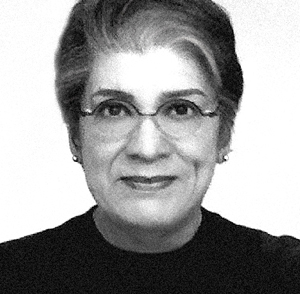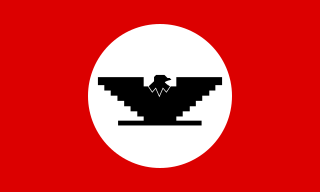Related Research Articles
Harry Gamboa Jr. is an American Chicano essayist, photographer, director, illustrator, and performance artist. He was a founding member of the influential Chicano performance art collective Asco.

Gronk, born Glugio Nicandro, is a Chicano painter, printmaker, and performance artist. His work is collected by museums around the country including the Smithsonian American Art Museum.
Elsa Flores is a well known Chicana street artist. Her mother's name was Maria Valenzuela and she was originally from a small village called San Javier located in Sinaloa, Mexico. She is one of the best known members of the Chicano street art movement.
Gilbert "Magu" Luján was a Chicano American sculptor, muralist, painter, and educator. He was a founding member of the Chicano collective, Los Four that consisted of artists Carlos Almaraz, Beto de la Rocha, Frank Romero and himself. In 1974, Judithe Hernández became the "fifth member," and only female member of Los Four.

Self Help Graphics & Art, Inc. is a community arts center in East Los Angeles, California, United States. Established in 1970, Self Help Graphics served as a critical locus of activity during the Chicano art movement and is a center for Chicano and Latino artistic production. SHG is most well-known for organizing annual Day of the Dead festivities, in addition to hosting exhibitions and musical performances. Throughout its history, the organization has worked with well-known artists in the Los Angeles area such as Barbara Carrasco, Los Four, the East Los Streetscapers, and Shizu Saldamando.

Judithe Hernández is an American artist and educator, she is known as a muralist, pastel artist, and painter. She is a pioneer of the Chicano art movement and a former member of the art collective Los Four. She is based in Los Angeles, California and previously lived in Chicago.
Patssi Valdez is an American Chicana artist. She is a founding member of the art collective Asco. Valdez's work represents some of the finest Chicana avant-garde expressionism, working with an array of mediums, such as painting, sculpture, and fashion design. She lives and works in Los Angeles, California.
Willie F. Herrón III is an American Chicano muralist, performance artist and commercial artist. Herrón was also one of the founding members of ASCO, the East Los Angeles based Chicano artists collective .

Asco was an East Los Angeles based Chicano artist collective, active from 1972 to 1987. Asco adopted its name as a collective in 1973, making a direct reference to the word's significance in Spanish ("asco"), which is disgust or repulsion. Asco's work throughout 1970s and 1980s responded specifically to socioeconomic and political problems surrounding the Chicano community in the United States, as well the Vietnam War. Harry Gamboa Jr., Glugio "Gronk" Nicandro, Willie F. Herrón III and Patssi Valdez form the core members of the group.
Laura Aguilar was an American photographer. She was born with auditory dyslexia and attributed her start in photography to her brother, who showed her how to develop in dark rooms. She was mostly self-taught, although she took some photography courses at East Los Angeles College, where her second solo exhibition, Laura Aguilar: Show and Tell, was held. Aguilar used visual art to bring forth marginalized identities, especially within the LA Queer scene and Latinx communities. Before the term Intersectionality was used commonly, Aguilar captured the largely invisible identities of large bodied, queer, working-class, brown people in the form of portraits. Often using her naked body as a subject, she used photography to empower herself and her inner struggles to reclaim her own identity as "Laura" – a lesbian, fat, disabled, and brown person. Although work on Chicana/os is limited, Aguilar has become an essential figure in Chicano art history and is often regarded as an early "pioneer of intersectional feminism" for her outright and uncensored work. Some of her most well-known works are Three Eagles Flying, The Plush Pony Series, and Nature Self Portraits. Aguilar has been noted for her collaboration with cultural scholars such as Yvonne Yarbo-Berjano and receiving inspiration from other artists like Judy Dater. She was well known for her portraits, mostly of herself, and also focused upon people in marginalized communities, including LGBT and Latino subjects, self-love, and social stigma of obesity.
rafa esparza, or Rafael Esparza, is an American performance artist who lives and works in Los Angeles. His work includes performances affecting his physical well-being and installations constructed from adobe bricks. Esparza often works with collaborators, including members of his family.
Gerardo Velazquez (1958–1992) was a visual artist and musician, who was notably a member of the Los Angeles-based punk group Nervous Gender. Nervous Gender was known for their confrontational and antagonistic performances that was unapologetically queer and anti-Catholic in theme.

Les Petites Bon-Bons was a group of conceptual/life artists that originated in Milwaukee, Wisconsin, in the early 1970s. Their activities spanned the nascent gay activist movement, the international correspondence network and the Hollywood glitter rock scene. They are known largely by the work of Jerry Dreva and Robert Lambert, aka Jerry and Bobby Bonbon, and who achieved much of their fame by effectively manipulating major media outlets.

Raymond Robert Navarro was an American video artist, filmmaker, and HIV/AIDS activist. Navarro was an active member of ACT UP and a founder of Diva TV. His activism was featured in the documentary How to Survive a Plague. Navarro's art was exhibited at the Institute of Contemporary Art, Boston, Museum of Contemporary Art, Los Angeles, Tacoma Art Museum, Bronx Museum of the Arts, and Museum of Contemporary Art, Cleveland, among others. Navarro's papers, videos, and artworks are held at the ONE National Gay & Lesbian Archives at the USC Libraries in Los Angeles.
Lucila Villaseñor Grijalva is a Chicana muralist who was born in Los Angeles, California. Her art style is inspired by graffiti art.
Claudia E Zapata is a Queer Chicanx artist and curator known as one of the co-founders of the Puro Chingón Collective, which develops BIPOC zines and designer toys. In 2023, Zapata became the first associate curator of Latino Art at the Blanton Museum in Austin, Texas.
Angélica Becerra is an activist visual artist who primarily works in watercolor and digital media.
Joey Terrill is an American Chicano queer visual artist. He works in the mediums of painting, collage, drawing, and photography. His work often pays tribute to gay visual artist, and features Chicano themes. Terrill uses inspiration from cartoons, magazines, 1950s and 1960s art movements, and comics to produce his work. He is based in Los Angeles.
The queer Chicano art scene emerged from Los Angeles during the late 1960s and early 1990s composing of queer Mexican American artists. The scene’s activity included motives and themes relating to political activism, social justice, and identity. The movement was influenced by the respective movements of gay liberation, Chicano civil rights, and women’s liberation. The social and political conditions impacting Chicano communities as well as queer people, including the HIV/AIDS epidemic, are conveyed in the scene’s expressive work.
C. Ondine Chavoya is an American art historian, art curator, author, editor, and educator. He is known for his work in Chicano/Latino and queer art history. Chavoya is the John D. Murchison Regents Professor in the department of art and art history at the University of Texas at Austin. He was a co-editor of Chicano and Chicana Art: A Critical Anthology.
References
- ↑ "Zully Mejia responds to Mundo Meza". An Inside View of the Barrick Museum. 2019-03-19. Retrieved 2019-10-30.
- 1 2 3 4 "Getty Foundation Awards Research Grant for Mundo Meza Exhibition | ONE Archives". one.usc.edu. Retrieved 2019-10-30.
- ↑ AIDS, Visual (2018-07-25), Simon Doonan on Mundo Meza | Talk + Tour: Axis Mundo , retrieved 2021-11-02
- ↑ Turner, Madeline M. (2019-02-12). "Axis Mundo: Queer Networks in Chicano L.A." ARTMargins. Retrieved 2021-11-01.
- 1 2 3 "Queer Chicanx Artists Find a Home in L.A.'s 'Axis Mundo' Exhibition". www.out.com. 2017-12-08. Retrieved 2019-10-30.
- ↑ "The untold stories of America's queer Chicano art scene". Dazed. 2017-10-16. Retrieved 2019-10-30.
- ↑ "Your Art Disgusts Me: Early Asco 1971-75". East of Borneo. Retrieved 2019-10-30.
- ↑ Assunção, Muri (2017-09-15). "Queer Chicano Art Is as Timeless As It Is Vital". Vice. Retrieved 2019-10-30.
- 1 2 "Mundo Meza". Williams College Museum of Art. Retrieved 2021-11-02.
- 1 2 3 4 "Edmundo "Mundo" Meza" (PDF). Edmundo "Mundo" Meza.
- ↑ "Your Art Disgusts Me: Early Asco 1971-75". East of Borneo. Retrieved 2019-10-30.
- ↑ Furman, Anna (2017-08-28). "Queer Chicano Artists and Activism in 1970s L.A." The Cut. Retrieved 2019-10-30.
- ↑ "An exhibition on L.A.'s queer Chicano networks shows how California artists connected with the world". Los Angeles Times. 2017-12-21. Retrieved 2019-10-30.
- ↑ Cassidy, Benjamin. "Historical look at queer networks in Chicano L.A." The Berkshire Eagle. Retrieved 2019-10-30.
- ↑ "Pacific Standard Time: LA/LA Grant Awarded". The Getty Foundation. Retrieved 2019-03-28.
- 1 2 "Traveling art exhibit 'Axis Mundo' highlights the work of LA's queer, Chicanx community". Las Vegas Weekly. Retrieved 2019-03-28.
- ↑ "Axis Mundo: Queer Networks in Chicano L.A." Los Angeles Magazine. 2017-12-01. Retrieved 2019-10-30.
- ↑ "Tribeca Art Spaces Yearn for Love in the Time of Cholera". Hyperallergic. 2018-06-25. Retrieved 2019-10-30.
- ↑ "Axis Mundo Catalogue wins The American Association of Art Museum Curators' Award for Excellence". Independent Curators International. Retrieved 2019-10-30.
- ↑ "Axis Mundo: Queer Networks in Chicano L.A." 205 Hudson Gallery. Retrieved 2019-10-30.
- ↑ "Houston's Lawndale Art Center Showcases First-ever Archive of LGBTQ Chicanx Art". OutSmart Magazine. 2019-05-07. Retrieved 2019-10-30.
- ↑ "Axis Mundo: Queer Networks in Chicano L.A." Williams College Museum of Art. Retrieved 2019-10-30.